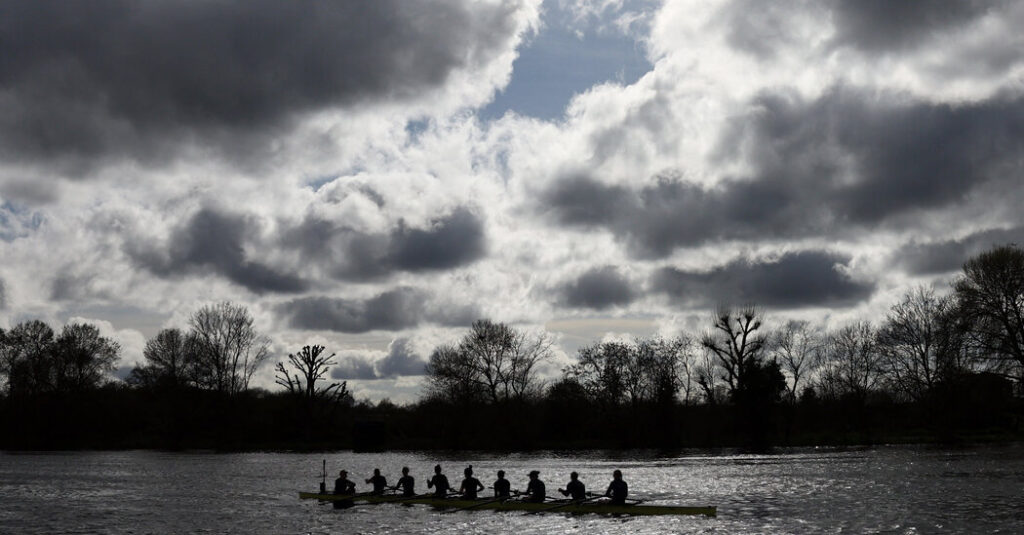The warning was stern: Do not enter the water. Not due to the tide. Not due to sharks. Because of the sewage.
For virtually two centuries, rowers from Oxford University have raced their rivals from Cambridge in a contest that sometimes ends with jubilant members of the victorious crew leaping into the River Thames in celebration.
This 12 months they are going to be staying as dry as attainable.
After the invention of elevated ranges of E. coli within the river, rowers have been urged to remain out of the water, to cowl any open wounds and to clean themselves down at a devoted cleaning station on the end.
The warning from organizers of the annual competitors often called the Boat Race is probably the most putting image of the dire and deteriorating state of Britain’s rivers and coastlines. E. coli, which may be contracted from inadequately handled water provides, could cause quite a lot of signs together with diarrhea, abdomen cramps and sometimes fever. According to Britain’s well being service, a small variety of folks may also develop hemolytic uraemic syndrome which may generally result in kidney failure and demise.
In latest years, England’s personal water firms have confronted fierce criticism for discharging sewerage and untreated rainwater into waterways and onto seashores when rainfall is heavy — a tactic they use to forestall the system from backing up.
Water corporations in England had been privatized in 1989, and critics accuse them of paying out large sums in dividends to their shareholders whereas failing to make important infrastructure investments.
While campaigners have lengthy highlighted the issue with water high quality, few Britons may have anticipated contamination to influence the Boat Race, a fixture of the sporting calendar which attracts as much as 250,000 spectators in addition to a TV viewers of tens of millions, organizers say.
Rowers from the 2 historic universities will compete over the 4.25-mile course on the Thames on Saturday afternoon, the 169th males’s and 78th ladies’s races.
The first Boat Race occurred on 10 June 1829 at Henley-on-Thames, west of London, and was gained by Oxford. However, for the subsequent 25 years, contests occurred irregularly and, from 1836, within the nationwide capital. They grew to become annual occasions in 1856. A ladies’s boat race was launched in 1927 however solely occurred intermittently till the mid-Nineteen Sixties.
The new steering follows testing of the Thames by River Action, a charity that campaigns for cleaner waterways and stated that its checks revealed ranges of E. coli as much as 10 occasions increased than the minimal accepted requirements for bathing water.
The testing areas instructed that the supply of air pollution was from Thames Water, the native water firm, “discharging sewage directly into the river and its tributaries,” River Action stated in a press release.
“We are in a tragic situation when elite athletes are issued with health guidance ahead of a historic race on the capital’s river,” stated James Wallace, chief govt officer of River Action. “Our water quality results show what happens after decades of neglect by an unregulated water company, Thames Water.”
The Boat Race, an organization that places on the race and was arrange by the Oxford and Cambridge Rowing Foundation, stated that it “and the universities involved love rowing on the Thames,” however that “water quality is an ongoing concern.”
In a press release it added: “We have put in place a series of precautionary measures this year to protect the health of our athletes, which includes guidance regarding the covering up of open wounds, regular hand washing, a cleansing station at the finish area and highlighting the risks of entering the water.”
Most of Britain depends on a mixed sewer system that pushes each rainwater and human waste alongside the identical set of pipes.
When rainfall is heavy, water corporations are generally permitted to discharge a few of this into rivers or the ocean to keep away from the pipes being overwhelmed, one thing that would trigger sewage to again up and flood roads and houses.
Critics accuse the water corporations of spilling sewage even in dry climate and, in line with figures launched on Wednesday, final 12 months there have been on common 1,271 spills a day throughout England, in contrast with 825 in 2022.
In a press release, Thames Water, the utility that’s accountable, blamed “higher than average long-term rainfall across London and the Thames Valley.” It stated overflows had been designed to function robotically when the sewer community was about to be overwhelmed, in order that diluted wastewater could be launched into rivers as an alternative of flowing “back up into people’s homes.”
The firm added that it was “working hard to make these discharges unnecessary” and had introduced plans to improve one sewage remedy plant, in southwest London, “to treat the high volumes of incoming sewage and reduce the need for overflows during wet weather.”
That could also be of little consolation to this 12 months’s rowers who know that, even when they take all of the precautions suggested, historical past suggests there is no such thing as a assure they’ll keep out of the Thames.
In 1912 each crews had been submerged by unhealthy climate, and the latest sinking occurred in 1984 when the Cambridge males’s boat hit a barge earlier than the race had even began.


